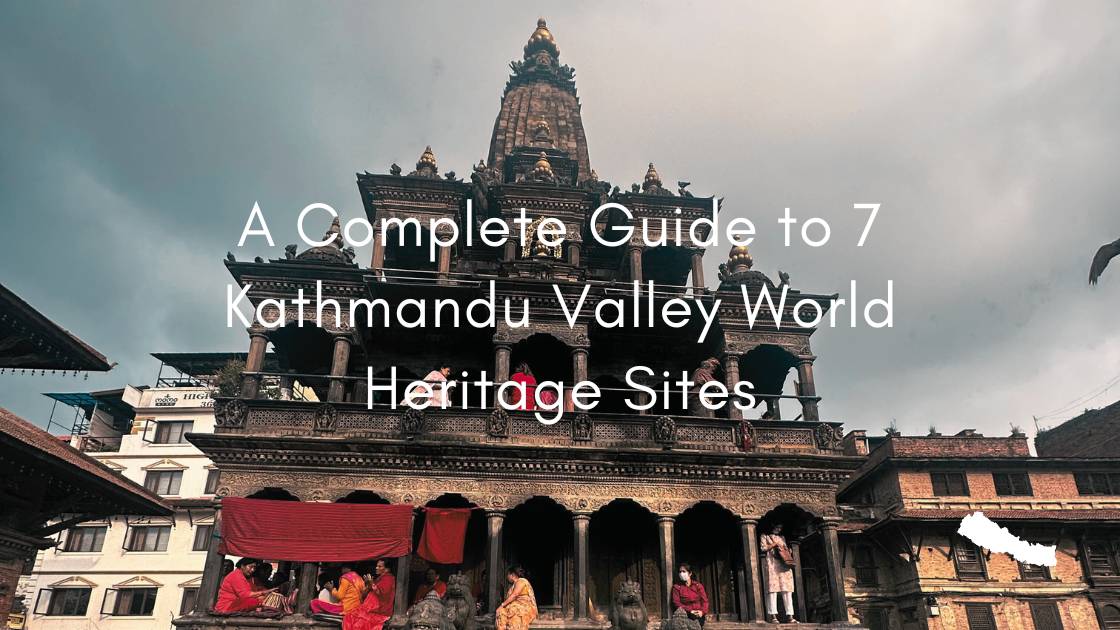
A Complete Guide to the 7 World Heritage Site of Kathmandu Valley
Overview
Kathmandu Valley World Heritage Site has a rich history, culture, and spirituality. It is well known as a UNESCO World Heritage Site with seven iconic landmarks that showcase the rich tapestry of Nepal’s heritage. From the historic royal castles of Kathmandu Durbar Square to the sacred expedition sites of Pashupatinath Temple and Swayambhunath Stupa, every corner of the valley narrates a tale of resilience, creativity, and devotion.
Let’s dive into a journey where we will explore each heritage site once at a time. Our main goal is to offer readers a complete guide that reveals the secrets and treasures of this iconic Kathmandu Valley World Heritage Site. Through detailed descriptions and historical insights, we aim to illuminate architectural marvels, cultural importance, and spiritual essence that make these sites extraordinary.
History and Cultural Heritage:
Explore centuries of civilization and religious influence in Kathmandu Valley’s rich history and cultural heritage.
Discover the valley’s originality through dynasties, rulers, and cultural developments.
Monuments and temples in the valley represent diverse religious traditions and architectural styles.
Opening the Gates of History:
Step back in time as you wander through the ancient squares of Kathmandu, Patan, and Bhaktapur Durbar Square. Each stone tells a story, echoing the footsteps of kings, artisans, and pilgrims who shaped the valley’s legacy. Explore intricately carved palaces, temples, and courtyards of the valley’s glorious past among Kathmandu valley world heritage sites.
Holy Sanctuaries and Spiritual Splendor:
Ascend the steps of Swayambhunath Stupa, affectionately known as the Monkey Temple, and be greeted by the watchful eyes of the Buddha. Feel the energy roll through Boudhanath Stupa, a beacon of peace and harmony for calmness. Experience the sacred rituals of Pashupatinath Temple, where devotees pay homage to Lord Shiva amidst the flickering flames of funeral pyres.
Journeying Through Architectural Marvels:
Admire the intricate woodwork of Changunarayan Temple, a masterpiece of Newari craftsmanship dating back to the Licchavi period. Explore the hidden courtyards and witness a treasure trove of medieval architecture and urban design. Wander through the labyrinthine streets of Bhaktapur, where every brick and tile tells a tale of resilience and artistry.
List of 7 UNESCO Kathmandu Valley World Heritage Sites
- Kathmandu Durbar Square
- Patan Durbar Square
- Bhaktapur Durbar Square
- Swayambhunath Stupa (Monkey Temple)
- Boudhanath Stupa
- Pashupatinath Temple
- Changunarayan Temple
Kathmandu Durbar Square:
Kathmandu Durbar Square is a popular tourist destination in the epicenter of Kathmandu city. It showcases a mix of classical historic monuments, art, and technology. It was once the royal palace for the ‘Malla’ and ‘Shah’ kings. This square is a well-known UNESCO World Heritage Site with a combination of architectural styles, including Newari, Mughal, and European influences.
Key attractions include the Hanuman Dhoka Palace, Kumari Ghar (residence of the Living Goddess Kumari), Taleju Temple, Jagannath Temple, and Kasthamandap (believed to be the oldest wooden building in Nepal).
Patan Durbar Square:
Patan Durbar Square is a cultural gem of the Kathmandu Valley. It is famous for its beautiful Newari architecture, intricate temples, and ancient palaces dating back to the medieval period. It offers a glance into the authentic lifestyle of the Newari people amidst the bustling city crowd in the evening. The city of Patan itself is renowned for its rich Newari heritage and craftsmanship. It is adorned with intricately carved wooden temples, shrines, courtyards, and palaces, showcasing the finest examples of Newari architecture.
The highlights of Patan Durbar Square include the Krishna Mandir, a masterpiece of stone architecture, the Golden Temple (Hiranya Varna Mahavihar), an exquisite Buddhist monastery, and the Patan Museum, which exhibits traditional art and artifacts.
Bhaktapur Durbar Square:
Step back in time as you wander through the cobblestone streets and the well-preserved architecture of Bhaktapur Durbar Square, a living museum of Newari culture and tradition. It is an antique plaza in Bhaktapur, renowned for its well-preserved medieval architecture and cultural heritage. The square is adorned with temples, palaces, statues, and courtyards, reflecting the grandeur of the Malla dynasty.
Notable attractions include the Nyatapola Temple, a five-story pagoda temple towering over the square; the 55 Window Palace, showcasing exquisite wood carvings; and the Bhairavnath Temple, dedicated to the fierce deity Bhairava.
Swayambhunath Stupa (Monkey Temple):
Swayambhunath Stupa is a sacred Buddhist site on a hill west of Kathmandu Valley in Nepal. It is one of the oldest and most respected Buddhist shrines. From the top, visitors can enjoy breathtaking views of the city and the surrounding hills. They can also climb the steps to the stupa’s dome and witness the mischievous activities of the resident monkeys.
The stupa is decorated with colorful blessing flags, intricate carvings, and the famous ‘All-Seeing Eyes of Buddha’ painted on its white dome. The area around the stupa is filled with monasteries, shrines, and Tibetan Buddhist prayer wheels, creating a peaceful and spiritual atmosphere.
Boudhanath Stupa:
A sacred pilgrimage site for Buddhists, Boudhanath Stupa is a monumental symbol of peace and enlightenment. The Boudhanath Stupa is one of the largest stupas in the world and a focal point of Tibetan Buddhism in Kathmandu. The stupa’s massive dome, adorned with prayer flags and Buddha’s eyes, symbolizes enlightenment and wisdom.
Surrounding the stupa are monasteries, handicraft shops, and traditional Tibetan eateries, making it a vibrant hub of culture and spirituality.
Pashupatinath Temple:
Revered as one of the holiest Hindu shrines in the world, Pashupatinath Temple is dedicated to Lord Shiva and attracts devotees and pilgrims from far and wide. The temple complex comprises numerous shrines, ghats (cremation platforms), and ashrams along the Bagmati River, where Hindu cremation ceremonies are held.
Visitors can witness elaborate rituals, Sadhus (Hindu holy men), and devotees performing prayers and ceremonies on the temple premises.
Changunarayan Temple:
Changunarayan Temple is on a hill in the village of Changu, near Bhaktapur. It is an ancient Hindu temple known for its beautiful stone carvings and sculptures. The temple, dating back to the Licchavi period, is dedicated to Lord Vishnu and is one of the oldest Hindu temples in Nepal, dating back to the 4th century.
The temple is renowned for its exquisite stone carving, depicting Hindu deities, mythical creatures, and scenes from Hindu epics like the Ramayana and Mahabharata.
Practical Tips for the Adventurous Traveler
Planning your pilgrimage to Kathmandu Valley? Here are some insider tips to ensure a seamless and unforgettable experience. Allow us to plan your pilgrimage to Kathmandu Valley’s World Heritage Sites meticulously, considering factors such as transportation, accommodation, and entry fees.
- Visit the sites during off-peak hours or seasons for an intimate and immersive experience.
- Immerse yourself in the local culture by participating in guided tours, cultural activities, and traditional rituals.
- Participate in the local culture to indulge in cultural activities and traditional rituals if your tour collides.
- Taste the authentic Nepali cuisine at local eateries, savoring the flavors and supporting the local economy.
- Stay updated on weather forecasts and local regulations, ensuring a safe and enjoyable experience during your visit to the World Heritage Sites.
- Respect the cultural and religious significance of the sites by following guidelines and etiquette, such as dressing modestly and refraining from disruptive behavior.
- Capture memories of your journey through photography, but be mindful of restrictions and guidelines regarding photography.
- Leave no trace behind and practice responsible tourism by disposing of waste properly and minimizing your environmental impact.
Preserving the Past for Future Generations
Along with our visit to the heritage sites at Kathmandu Valley, it is our collective responsibility to protect and preserve these sacred sites for generations to come. Join us in supporting conservation efforts and sustainable tourism practices that ensure the integrity and authenticity of the valley’s World Heritage Sites. Together, we can safeguard this invaluable legacy and continue to share its beauty and significance with the world.
- Commitment to conservation: We are dedicated to preserving Kathmandu Valley’s rich cultural heritage for future generations to enjoy and appreciate.
- Sustainable tourism practices: Promoting responsible tourism initiatives to minimize the environmental impact and ensure the long-term sustainability of the World Heritage Sites.
- Community involvement: Engaging local communities in heritage conservation efforts, fostering a sense of ownership and pride in preserving their cultural legacy.
- Collaboration with stakeholders: Partnering with government agencies, non-profit organizations, and other stakeholders to implement effective preservation strategies and initiatives.
- Education and awareness: Raising awareness about the importance of cultural heritage preservation through educational programs, workshops, and outreach activities.
- Advocacy for funding and support: Lobbying for increased funding and support from government agencies, international organizations, and private donors to sustain conservation efforts.
Conclusion:
Kathmandu valley world heritage site shines with its timeless allure and spiritual grace, inviting travelers to embark on a journey of discovery and enlightenment. From ancient temples to medieval palaces, each corner of the valley tells a story of resilience, creativity, and reverence. As you explore the World Heritage Sites of Kathmandu Valley, may you find inspiration, wonder, and a deep appreciation for the cultural treasures that bind us to our past and shape our future.
Frequently Asked Questions (FAQs)
1. How many UNESCO registered sites does Kathmandu Valley hold?
There are seven culturally and historically significant landmarks recognized by the United Nations Educational Scientific and Cultural Organization (UNESCO). These include Kathmandu Durbar Square, Patan Durbar Square, Bhaktapur Durbar Square, Swayambhunath Stupa (Monkey Temple), Boudhanath Stupa, Pashupatinath Temple, and Changu Narayan Temple.
2. Are there any dress codes or cultural etiquettes to follow when visiting these sites?
There are no dress codes, although some sites require you to open your footwear before entering temples and monuments. Some antique areas are prohibited from taking photographs.
3. What makes these sites special?
These sites are of great architectural, religious, and cultural importance, representing a long history and skilled craftsmanship. They display detailed carvings, old palaces, impressive stupas, and respected temples, highlighting Nepal’s abundant cultural heritage.
4. How can I visit these sites?
You can explore the World Heritage Sites of Kathmandu Valley independently or join our guided tours. Transportation options include taxis, public buses, and hired vehicles. Many of these sites are located within close proximity to each other, making it convenient to visit multiple sites in a day.
5. Are there any entry fees for visiting these sites?
Yes, entry fees are applicable for most of the World Heritage Sites in Kathmandu Valley. The fees vary for Nepali nationals, SAARC nationals, and foreign tourists. Some sites may offer discounted rates for students and children.
6. Can I combine visits to multiple sites in a single day?
Yes! You can visit multiple sites with proper planning , or you can allow us to serve our guided tours and provide you with meticulously designed travel packages.


